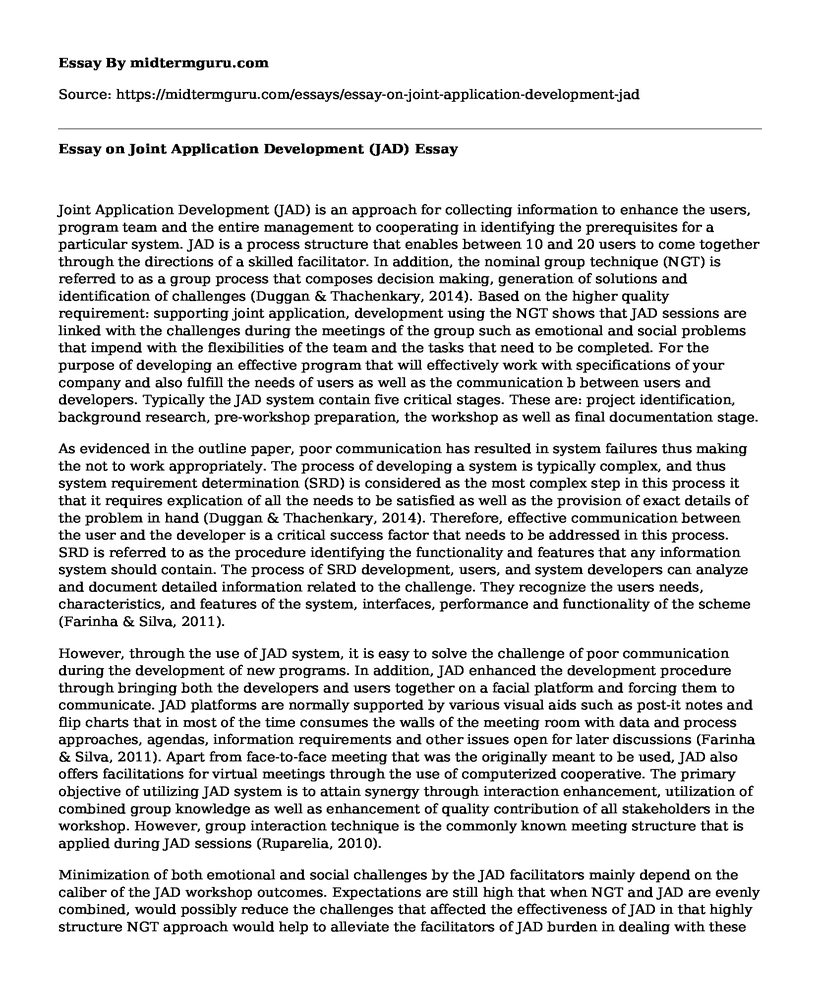Joint Application Development (JAD) is an approach for collecting information to enhance the users, program team and the entire management to cooperating in identifying the prerequisites for a particular system. JAD is a process structure that enables between 10 and 20 users to come together through the directions of a skilled facilitator. In addition, the nominal group technique (NGT) is referred to as a group process that composes decision making, generation of solutions and identification of challenges (Duggan & Thachenkary, 2014). Based on the higher quality requirement: supporting joint application, development using the NGT shows that JAD sessions are linked with the challenges during the meetings of the group such as emotional and social problems that impend with the flexibilities of the team and the tasks that need to be completed. For the purpose of developing an effective program that will effectively work with specifications of your company and also fulfill the needs of users as well as the communication b between users and developers. Typically the JAD system contain five critical stages. These are: project identification, background research, pre-workshop preparation, the workshop as well as final documentation stage.
As evidenced in the outline paper, poor communication has resulted in system failures thus making the not to work appropriately. The process of developing a system is typically complex, and thus system requirement determination (SRD) is considered as the most complex step in this process it that it requires explication of all the needs to be satisfied as well as the provision of exact details of the problem in hand (Duggan & Thachenkary, 2014). Therefore, effective communication between the user and the developer is a critical success factor that needs to be addressed in this process. SRD is referred to as the procedure identifying the functionality and features that any information system should contain. The process of SRD development, users, and system developers can analyze and document detailed information related to the challenge. They recognize the users needs, characteristics, and features of the system, interfaces, performance and functionality of the scheme (Farinha & Silva, 2011).
However, through the use of JAD system, it is easy to solve the challenge of poor communication during the development of new programs. In addition, JAD enhanced the development procedure through bringing both the developers and users together on a facial platform and forcing them to communicate. JAD platforms are normally supported by various visual aids such as post-it notes and flip charts that in most of the time consumes the walls of the meeting room with data and process approaches, agendas, information requirements and other issues open for later discussions (Farinha & Silva, 2011). Apart from face-to-face meeting that was the originally meant to be used, JAD also offers facilitations for virtual meetings through the use of computerized cooperative. The primary objective of utilizing JAD system is to attain synergy through interaction enhancement, utilization of combined group knowledge as well as enhancement of quality contribution of all stakeholders in the workshop. However, group interaction technique is the commonly known meeting structure that is applied during JAD sessions (Ruparelia, 2010).
Minimization of both emotional and social challenges by the JAD facilitators mainly depend on the caliber of the JAD workshop outcomes. Expectations are still high that when NGT and JAD are evenly combined, would possibly reduce the challenges that affected the effectiveness of JAD in that highly structure NGT approach would help to alleviate the facilitators of JAD burden in dealing with these difficulties (Ruparelia, 2010).
References
Duggan, E. W., & Thachenkary, C. S. (2014). Integrating nominal group technique and joint application development for improved systems requirements determination. Information & Management, 41(4), 399-411.
Farinha, C., & Da Silva, M. M. (2011). Web-based focus groups for requirements elicitation. group, 13, 17.
Ruparelia, N. B. (2010). Software development lifecycle models. ACM SIGSOFT Software Engineering Notes, 35(3), 8-13.
Cite this page
Essay on Joint Application Development (JAD). (2021, Jun 25). Retrieved from https://midtermguru.com/essays/essay-on-joint-application-development-jad
If you are the original author of this essay and no longer wish to have it published on the midtermguru.com website, please click below to request its removal:
- Problem Identification and Background in Social Framework - Essay Sample
- Summarize Bass' Leadership Approaches - Paper Example
- Personal Statement Example: MSc in Software Engineering
- Essay Sample on Nursing Leadership and Provision
- Achieving Change: The Impact of People and Processes - Essay Sample
- Dynamic Governance: Stitch Fix's Criteria, Diversity, & Refreshment - Essay Sample
- Digital Market Plan: Leveraging Microcomputers' Life Cycle - Essay Sample







